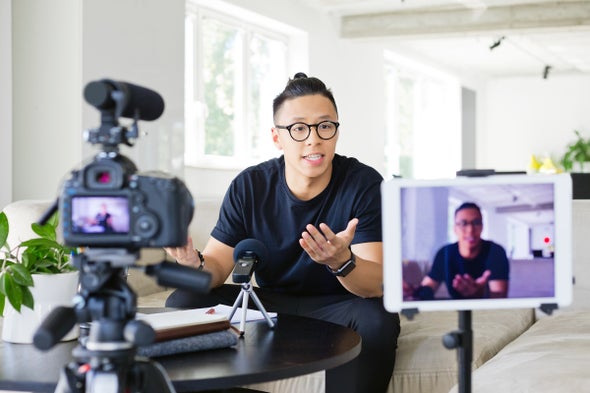Why Do We Post On Social Media

Every time I log onto Facebook, I brace myself. My newsfeed—like everyone else's I know—is filled with friends, relatives and acquaintances arguing about COVID-19, masks and Trump. Facebook has become a battleground among partisan "echo chambers." But what is it about social media that makes people so polarized?
To find out, my colleagues and I ran a social media experiment in which we divided Democrats and Republicans into "echo chambers," or small groups whose members affiliate with just one political party. Next, we picked the most polarizing issues we could think of: immigration, gun control and unemployment. We asked each participant what they thought of those issues, then let people talk to each other and revise their opinions. After several rounds of discussion and revision, we evaluated each group's viewpoint.
To our surprise, the echo chambers did not make people more polarized, but less. After interacting in social networks with likeminded peers, each echo chamber—Republican and Democrat—had adopted a more moderate opinion. All groups independently moved toward opinions that were closer to the opinions on the "opposite" side of the political spectrum.
As a scientist who studies networks, I'm used to being surprised by the results of my experiments. Technology has allowed us to access more information and data about people's social networks, debunking many of our assumptions about human behavior. But even my team at the Network Dynamics Group was surprised: Why did our social media experiment find the opposite of what happens all the time in the real world of social media?
The answer lies in something social media has amplified: "influencers."
By now, most of us have a fairly specific understanding of what an "influencer" is. The word conjures up a young, wealthy person whose lifestyle is sponsored by brands like Instagram, TikTok or YouTube. But the word has a very specific network science meaning. In social media, networks tend to be centralized: a small number of people, or perhaps just one person, at the "center" of the network is connected to lots of other people in the "periphery." The multitudes in the periphery of the social network have only a modest number of connections, while the few—the so-called "influencers"—at the center of the network are connected to nearly everyone. This puts these people into the powerful position of being able to exert a disproportionate level of "influence" over the group.
By contrast, the networks used in our study were "egalitarian"—the opposite of centralized. In an egalitarian network, everyone has an equal number of contacts, and therefore influence, throughout the network.
The key feature of an egalitarian network is that new ideas and opinions can emerge from anywhere in the community and spread to everyone. But in centralized networks—like many social media sites—ideas are filtered through, or sometimes even blocked, by a powerful social influencer. As I show in my upcoming book Change: The Power in the Periphery to Make Big Things Happen , centralized and egalitarian networks have very different effects on partisan bias and the acceptance of new ideas.
In a centralized echo chamber, if the influencer at the middle shows even a small amount of partisan bias, it can become amplified throughout the entire group. But in egalitarian networks, ideas spread based on their quality, and not the person touting them. There is a lot of wisdom in network peripheries, in regular people with good ideas. When the social network enables those people to talk with each other, new thinking that challenge a group's biases can take hold and spread.
To see how egalitarian networks might affect other kinds of contentious issues, we conducted another experiment with smokers and nonsmokers discussing the risks of cigarette smoking. The effects were the same as with the partisan study. Both groups moved toward a more accurate understanding of smoking risks. Moreover, when participants were interviewed after the study, they reported having developed higher opinions of the other. Both smokers and nonsmokers had come to view the other group as more reasonable and trustworthy about the risks of smoking. But the exchange of ideas and eradication of bias only works when networks are egalitarian.
The problem of partisan bias is exacerbated on social media because online networks are often organized around a few key influencers. This feature of social media is one of the main reasons why misinformation and fake news has become so pervasive. In centralized networks, biased influencers have a disproportionate impact on their community—enabling small rumors and suppositions to become amplified into widespread misconceptions and false beliefs.
Our country has been struggling with bias and polarization a long time. But the issue is about to get much more urgent. As the debate over COVID-19 vaccination heats up, biased viewpoints will undoubtedly become entrenched in communities with powerful influencers at their center. If we want to eradicate, or at least lessen the impacts of the coronavirus, we should rethink how our online communities operate. The solution to the problem of vaccine hesitancy is not to eliminate echo chambers. Rather, it is to be intentional about the social networks in those echo chambers. The more equity in people's social networks, the less biased and more informed groups will become—even when those groups start off with highly partisan opinions.
Damon Centola, Ph.D., is a professor at the Annenberg School for Communication and the School of Engineering and Applied Sciences at the University of Pennsylvania, where he is director of the Network Dynamics Group. His new book, Change: The Power in the Periphery to Make Big Things Happen , will go on sale on January 19, 2021.
Why Do We Post On Social Media
Source: https://www.scientificamerican.com/article/why-social-media-makes-us-more-polarized-and-how-to-fix-it/
Posted by: valenzuelacountim.blogspot.com

0 Response to "Why Do We Post On Social Media"
Post a Comment